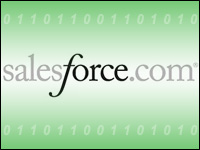
We’ve watched as Salesforce emerged from the crowd in the dot-com era to become a massive company with a US$7 billion run rate. We also have changed perspectives several times on what to expect from Dreamforce.
Not so long ago, we were (OK, I was) interested mostly in cool new technologies and business models, but as Salesforce has grown, it has acquired a following of financial analysts as well as industry analysts like me.
The finance types want to know about what will move the stock price in the year ahead, and that has changed how we view the company. A couple of years ago, Marc Benioff was talking about the marketing cloud as the next billion-dollar cloud, and that was largely messaging candy for the financial community.
However, there are other clouds, products and directions to consider as we move into Dreamforce season. Most have cool new technology and blue-ocean business models and, I hope, something to excite the earnings-per-share crowd. Here is my take on what we might see at Dreamforce.
There Will Be Crowds
OK, that’s a non sequitur, but it’s true. Dreamforce is expected to draw nearly 200,000 registrants this year. Where they’ll stay and what they’ll use for water in parched San Francisco is anyone’s guess.
I hear they’re opening up the hotel tab to Airbnb. We’ll see. As long as the city has enough water to make ice, we’ll be fine.
The Push for Platform
Platform is the most important thing Salesforce can promote at this point.
While CRM continues to be important, and there is still a great deal of open market space, having all those Magic Quadrant rankings on its side provides a certain amount of built-in momentum. True, the company still fights hard for every deal — but I am looking elsewhere for it to push ideas.
The platform is important for building new applications for myriad devices and partner companies. The partner community will be the next engine of growth for Salesforce. Actually, that engine already is revving, because there are thousands of partners building apps and selling seats.
Since enterprises still make many of their own apps, a platform that makes the process fast and easy will be important to them. There are more opportunities for selling developer seats than for selling CRM seats, so I look for Salesforce to accentuate platform further. It already has announced Lightning improvements, and there will be more to talk about around Dreamforce.
Sales, Marketing, Service
Salesforce has a history of being exceptionally nimble, never staying too long at any particular party before finding a new one. It was all about SaaS until it was reborn social, and then it skipped into devices and platforms. There were more evolutions than those, but you get the picture.
So what’s next? I suggest a focus on process as the logical evolution of transaction-oriented systems of record. It’s already happening to an extent, and all of the major acquisitions and product extensions of the last few years add up to providing a platform for building process-centric applications.
Journey maps, omnipotent code generation, analytics, a vastly improved UI and user-friendly analytics only make sense if you can put them together to drive processes.
I think transaction-oriented business apps are on the way out, and how Salesforce addresses this at Dreamforce will determine how fast it happens. The stovepipes always will be important — but increasingly, we’ll think of them as one big idea.
The Salesforce Foundation
The Salesforce Foundation does great work, and it should be touted because too few corporations have an outlook of giving back today. It’s definitely refreshing to see the company’s unwavering commitment.
There is a “but,” however. In recent years. we’ve seen the first hour of the first Benioff keynote devoted to the foundation. Laudable as its work is, I think that order needs to be changed. The first hour is when the audience has a fresh mind, and it is the time to bring out your most important messages. The foundation easily can come later in the preso. I hope this doesn’t sound churlish; it is simply intended to offer some perspective.
The Ecosystem
The number and quality of companies participating as ecosystem partners is truly impressive. At the first few Dreamforce meetups, there were a bunch of widget makers on the show floor. Today, in addition to upstarts, there are other public companies that have thrown in their lot with Salesforce and come up winners.
The show is worth attending just to see them, and if your interest is not specifically in Salesforce, I hope you’ll keep this in mind and walk the floors. You’ll get a sense of tomorrow. This year I expect to see a number of device vendors and messaging around the Internet of Things.
The Unquantifiable
When I wrote my last book, I interviewed an executive from New England Biolabs, a company that makes enzymes and reagents for genetic engineering. It goes to Dreamforce. One year it went and got inspired by the story about GE aircraft engines on the Internet of Things and asked itself what it could do to help its customers along the same lines.
The company sketched out a new product/service for delivering its wares that relies on the Salesforce platform, and it has been very successful deploying the idea. The point is — and I know this sounds corny — that Dreamforce turns out to be aptly named. You go there, get inspired, and invent things — and that happens more than you think. Of course, I have no data to prove it, but it’s true.
Salesforce has become a cash-generating machine for sure, but it’s still the same big idea, blue-ocean company many of us have been following for all this century. That’s why I go to Dreamforce.
























































